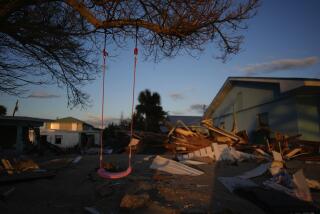Power Poles Were Pushover for Wilma
- Share via
FORT LAUDERDALE, Fla. — In Tamarac, Fla., a woman complained for years to Florida Power & Light Co. about a decayed utility pole, one so decrepit that a tree was growing out of it. The company never replaced it, and the pole snapped in Hurricane Wilma, leaving her without electricity for 11 days.
In Lighthouse Point, Fla., frustrated by years of power outages, the mayor hired a consultant who earlier this year found 27 poles in need of repair. Many of them were even more damaged after this hurricane season, the mayor said.
In the Croissant Park section of Fort Lauderdale, a couple warned FPL last year about a hollowed-out pole so riddled with woodpecker holes that cable and telephone workers refused to climb it. It too went down in the storm.
“We reported this so that exactly what happened wouldn’t happen,” said Danny DeAvies, standing next to the broken wooden shaft behind his house in Croissant Park. “That’s what drives me crazy. My pole’s rotten. We report the pole’s rotten, and it goes down.”
Throughout South Florida, these stories of poorly maintained utility poles and FPL’s failure to respond are being told by angry residents, frustrated by days of power outages they believe could have been avoided if the company had paid attention to their complaints.
As Hurricane Wilma crossed South Florida on Oct. 24, it split or toppled an estimated 7,000 to 10,000 utility poles, contributing to power outages that left more than 98% of the region in the dark.
Almost two weeks later, 341,000 South Florida customers were still without power as of Saturday. Company executives say they were surprised by the amount of damage to poles.
But a July report by the Florida Public Service Commission had warned that FPL’s program for inspecting distribution poles was inadequate. It said the company’s contractor performed inspections at such a slow rate that it would take 60 years to reach all the poles in the system.
The report said FPL’s inspection system would allow “weakened and rotten poles to remain in service.”
Florida has no laws requiring that utility poles be regularly inspected, said Kevin Bloom, a commission spokesman.
In contrast, California has established regular inspection cycles and record-keeping requirements for its electric utility companies, which include checking wooden poles. In urban areas of California, most wooden poles must be visually inspected once a year.
FPL defended its pole inspection policy Friday, rejecting suggestions that its maintenance was deficient. A forensic team examining poles that fell during Wilma has found that many showed no signs of deterioration, said FPL spokesman Mayco Villafana.
“Our maintenance program is year-round,” he said. “We have invested more than $1 billion to enhance the distribution infrastructure since 1998.”
FPL says its poles are designed to withstand wind speeds of at least 118.6 mph. Wilma had sustained winds of 105 mph near its core, with most of South Florida experiencing winds of 75 to 95 mph.
State Sen. Walter G. “Skip” Campbell Jr. (D-Tamarac), whose district office has been closed for nearly two weeks because it doesn’t have power, called for an investigation of FPL’s pole failures by either the Legislature or the Public Service Commission.
“We need answers as to why so many poles went down,” Campbell said. “We’re going to have to investigate this and look at how they document inspections.”
As the debate over the company’s pole maintenance continues, the financial stakes are high. At some point, FPL is expected to go before the commission to seek customer surcharges to pay for damage from Hurricane Wilma.
More to Read
Sign up for Essential California
The most important California stories and recommendations in your inbox every morning.
You may occasionally receive promotional content from the Los Angeles Times.










